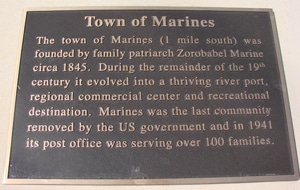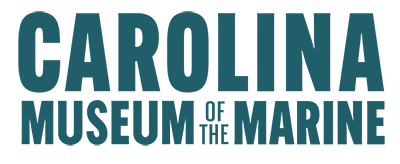The First Marines
Beginning during the summer of 1940, the Marine Corps had actively searched the east and Gulf coasts for a division training area. A selection board, headed by Colonel Julian C. Smith, who would later command the 2nd Marine Division during the epic battle for Tarawa, eventually settled on the New River area of Onslow County. One of the more desirable features of this area was the sheltered cove known as Courthouse Bay, so-called because on its shores at Jarrett’s Point was established Onslow County’s first courthouse. The Major General Commandant, Thomas Holcomb, defined a scope of twenty-one activities that were to be conducted in the training area; seven of these could be associated with and would eventually influence the development of the Courthouse Bay area, including its adjoining community.

Courthouse Bay’s appeal to the Marines was much the same as that of the settlers who for generations had built their homes, farms, landings, stores and small industries around the Bay’s periphery. The Bay would provide a protected anchorage and staging area for the landing craft and amphibian tractors that would train the Marines in their ship-to-shore movement along with the necessary repair and maintenance facilities, administrative support buildings and barracks. The Bay likewise allowed easy access to the New River; which in turn provided access to the other Base enclaves along the river; the New River Inlet; the landing beaches stretching northeastward toward Brown’s Inlet; the Atlantic Intracoastal Waterway with its landward maneuver areas and, by 1942, the amphibious transport mockup; and the training areas afforded by the expanse of the river itself and its shores.
And, it surely must be regarded as one of the more remarkable coincidences in the naming of geographic places that, decades before Camp Lejeune was even a twinkle in the Commandant’s eye, this adjoining, thriving community aboard what would become the Marine Corps’ premier amphibious base, was named ‘Marines.”
To begin at the beginning, the town of “Marines” at Courthouse Bay was begun by the Marine family patriarch Zorobabel Marine when he settled at that site in 1844 with his wife, the former Anne Elizabeth (Eliza) Covil. Zorobabel is believed to have been descended from the Marines that settled along the northwest branch of the Nanticoke River in Dorchester Count, Maryland, beginning in 1665. Zorobabel prospered as a yeoman farmer, enjoying likewise the bounty of the New River, and added his skills as a mechanic and house carpenter, and as a traveling lay-preacher associated with the Yopp Meeting House, to the growing community. To Zorobabel and Eliza were born in Marines two sons, Wiley, in 1845, and Lewis, in 1856.
Wiley grew in a maritime culture imbedded with farming and the exploitation of naval stores, and with the coming of the Civil War, served honorably with the 7th Confederate and 7th Georgia Cavalry Regiments. With Zorobabel’s passing in 1868, Wiley assumed family leadership and in conjunction with his brother Lewis, evidenced an entrepreneurship that eventually developed Marines into the largest town in the area subsequently taken by the U.S. Government, with a post office at that time that served approximately one-hundred families, a population that rivaled that of Snead’s Ferry, and that was regarded by Onslow’s most noted historian, Tucker Littleton, as the “most progressive” community in the county. Wiley can be justifiably credited with establishing Marines as a thriving river port and the nexus of commercial activity in the area, which, in the aggregate, claimed four general mercantile stores, two lumber mills, a grist mill, cotton gin, turpentine distillery, cooper’s shop, and several post offices, schools, churches, boathouses and piers.
Yet it would not be accurate to classify Wiley as simply a “local merchant.” He acquired land holdings in twenty-three separate transactions throughout the county, three of which were done in conjunction with his brother Lewis. His commercial enterprises extended beyond Marines to mercantile establishments in Jacksonville and Swansboro, and to a grocery outlet in Wilmington that offered New River’s fish and internationally recognized oysters to the populace of the lower Cape Fear. To stock the shelves of his various enterprises and transport goods to market, Wiley primarily utilized, along with the railroad, as many as three coast-wise schooners he owned and operated. The largest of these, the Roamer, a sixty-two-foot sharpie, was constructed in part at Harvey’s Point and Shipyard Landing on Wallace Creek, and was the last ocean-going sailing ship constructed in Onslow County.
Wiley and Lewis expanded their business into Jacksonville with its newly established railroad connection to Wilmington and New Bern in 1894 by purchasing a plot of land at the intersection of Main (also known as Bridge and later New Bridge) and Court Streets, an ideal location directly across from the 1884 courthouse (Onslow’s 7th) and then as later in the center of the commercial district. This plot was divided into two lots, the corner lot (at “Marine Corner”), owned by Lewis, was commonly referred to as the “Marine Lot” and the alley that separated this plot from the one to the east, and is still there, was known for years as “Marine Alley.” By no later than 1897, possibly using a local manager, they were operating a general merchandise store at that location as “Marine Brothers and Company, dealers in dry goods, notions, groceries and school books, etc.” Achieving success in this endeavor, and following the turn-of-the-century fire that destroyed the wooden structures on Court Street, Wiley constructed a two-story, brick building at the site in 1902 on his lot, adjacent to Lewis’s, to house the business, the first brick building in Jacksonville after the 1901 Hinton-Koonce store. (Their building, now identified with a plaque with the inscription “Margolis Building 1902,” should more appropriately have a plaque inscribed “Marine Building 1902,” since Max Margolis didn’t purchase it until 1923.)
By the fall of 1941, however, the last Marines’ post office was closed forever and its inhabitants dispersed to the winds, the unfortunate and regrettable consequence of a world situation and national emergency over which they had no control. One other unique feature of the town of Marines, however, that continued its significance was that more pre-existing structures were left in place after the area was cleared for construction than in any other locale aboard the base. As reported by Col Smith and the selection board to the Commandant, a number of these structures could be reused by the base. Indeed, six structures were spared, to include the summer residence of Dr C. I. Carlson, which served as the officers’ club for Courthouse Bay for several decades, and his boathouse on Harvey’s Point, which served the same recreational purpose for the base until it was replaced in 2002.
Zorobabel and his immediate family are interred in the Montford Point cemetery as testified by their headstones. The only other artifact of their and their town’s presence and contributions to Onslow County and Camp Lejeune’s history is Marines Road, which does not exist in name as a tribute to the warriors of Camp Lejeune, but as with many of the roads that transect Onslow County, and existed before the base, such as Piney Green and Sneads Ferry, its name derives from its final destination, the town of Marines. They were here first.
SELECTED BIBLIOGRAPHY
Rev. Levi Branson, A.M. Branson’s North Carolina Business Directory. Raleigh: various publishers, 1866-1896.
G.W. Carr and J.E. Greiner Co. Completion Report Covering the Design of Camp Lejeune U.S. Marine Barracks New River, N.C., for the U.S. Navy Bureau of Yards and Docks, Contract NOy 4751, April 15, 1941 – September 30, 1942. Durham and Baltimore: Carr and Greiner, 17 Jul 1943. 2 vols.
Census of the United States, Onslow County, N.C., 1850, 1860 and 1870.
Norwood Covil. Interview with author, Burgaw, N.C., 20 May 2005.
Bruce Harrison, Jr. Telephone interviews with author, Arapahoe, N.C., 2 May and 26 Jul 2005.
Kenneth B. Hurst. Interview with author, Jacksonville, N.C., 9 Mar 1995.
Elias Jones. Revised History of Dorchester County, MD. Baltimore: Read-Taylor Press, 1925.
Joe Jones. “Remembering Marines Before the Marines Came.” The State, Aug 1988.
LtCol L.J. Kimball, USMC (Ret). Consulting historian. Semper Fidelis: A Brief History of Onslow County, North Carolina, and Marine Corps Base, Camp Lejeune. Richmond: Louis Berger Group, Inc., 2002.
Thomas C. Loftfield and Tucker Littleton. Archaeological and Historical Survey of U.S.M.C. Base Camp Lejeune. 2 vols. Wilmington: University of NC at Wilmington, 1981.
Oscar Marine. Interviews with author, Sneads Ferry, N.C., 10 and 24 Jan, 12 Sep 1995.
The North Carolina Yearbook and Business Directory. Raleigh: The News and Observer, 1901-1941.
Onslow County. Records of Deeds. Onslow County Courthouse, Jacksonville, N.C.
“Original ‘Marines’ Settled New River Almost 200 Years Prior to the Leathernecks’ 1941 Arrival.” The Globe, 12 Jun 1958.
Property Map, Area-J, 1:3600, Marine Barracks, New River, N.C., YD 162774, 14 Aug 1941.
“Recollections of Oscar Marine.” Old Onslow Times, Apr 2000.
Jack Riley. “Coastal Towns Fall Before War Machine.” Raleigh News and Observer, 20 Apr 1941.
Frank Smith. Interview, Onslow County Public Library Oral History Program, Jacksonville, N.C., 4 Apr 1980.
Francis X. Tolbert. “River of Marines,” Leatherneck, Nov 1942.
Tract and Area Records. Technical Records Section, Public Works Division, Marine Corps Base, Camp Lejeune, N.C.
Posted on: July 2, 2021

